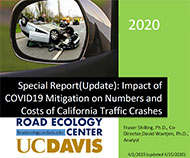Article from: www.thenewspaper.com/news/69/6925.asp
5/6/2020
California Study Exposes Myth Of Lockdown Superspeeding
University of California traffic data show crashes down during virus lockdown. Motorist speeds remain the same.
 The National Highway Traffic Safety Administration (NHTSA) on Tuesday released figures showing traffic fatalities in the United States continued to decline throughout 2019. Some public officials have been suggesting that the positive traffic safety results seen over the past three years has been replaced by the new danger of "superspeeding" while the virus scare empties roads nationwide. A recent traffic study suggests that these anecdotal claims are inaccurate.
The National Highway Traffic Safety Administration (NHTSA) on Tuesday released figures showing traffic fatalities in the United States continued to decline throughout 2019. Some public officials have been suggesting that the positive traffic safety results seen over the past three years has been replaced by the new danger of "superspeeding" while the virus scare empties roads nationwide. A recent traffic study suggests that these anecdotal claims are inaccurate.
NHTSA reported 36,120 highway fatalities last year, down 1.2 percent despite a 0.9 percent increase in traffic volumes. The reductions in fatalities were even greater for car accidents involving pedestrians and bicyclists, which saw 2 and 3 percent drops, respectively. At 1.1 fatalities per 100 million vehicle miles traveled, 2019 represented the second-lowest fatality rate the agency has recorded. Despite this, some are suggesting that 2020 results will be worse.
"This is good news, but clearly much work remains," Governors Highway Safety Association (GHSA) Executive Director Jonathan Adkins said in a statement Tuesday. "Late last month, many GHSA members reported that the Covid-19 crisis has led to more speeding on our roadways rather than the significant reduction in traffic crashes we would expect with the nation sheltering at home."
In a report released last month, the University of California, Davis Road Ecology Center used real-time traffic crash numbers from California Highway Patrol incident reports to conclude the Golden State's shelter-in-place mandate has slashed traffic crashes and fatalities. Crashes fell as the number of vehicles measured on the road dropped 55 percent.
"We estimate that since the order went into effect, collisions and especially injury and fatality collisions have been reduced by half, from [roughly] 1000 crashes and 400 injury/fatal crashes per day to 500 and 200 per day, respectively," the report explained.
Further validating the findings, the study found an equal reduction in the number of traffic-related hospital admissions in the Sacramento area. This included a 50 percent reduction in traumatic injuries for pedestrians and bicyclists.
Contrary to the anecdotal claims about "superspeeding" during the pandemic, the report found no major increase in the number of vehicles recorded exceeding the posted speed limit by significant amounts. Using traffic detector data from eleven freeways spread around the state, the researchers concluded there were "small" changes in average traffic speeds of between 1 and 4 MPH. The fastest drivers are found in 99th percentile data, which refers to drivers traveling faster than 99 percent of the rest of traffic. Peak 99th percentile travel speeds increased 3 MPH on State Route 88 in Ione, but the rest of the state saw increases of no more than 1 or 2 MPH.
National Motorists Association President Gary Biller suggests the media is exaggerating the number of drivers traveling over 100 MPH.
"One explanation might be that a small number of outliers create better headlines," Biller told TheNewspaper. "Another could be that police are using a very public enforcement tactic to prewarn drivers that, 'Hey, we're watching so you better slow down.'"
A copy of the UC Davis report is available in a 4mb PDF file at the source link below.
Source: Impact of COVID19 Mitigation on Numbers and Costs of California Traffic Crashes (UC Davis Road Ecology Center, 4/15/2020)
Permanent Link for this item
Return to Front Page
 The National Highway Traffic Safety Administration (NHTSA) on Tuesday released figures showing traffic fatalities in the United States continued to decline throughout 2019. Some public officials have been suggesting that the positive traffic safety results seen over the past three years has been replaced by the new danger of "superspeeding" while the virus scare empties roads nationwide. A recent traffic study suggests that these anecdotal claims are inaccurate.
The National Highway Traffic Safety Administration (NHTSA) on Tuesday released figures showing traffic fatalities in the United States continued to decline throughout 2019. Some public officials have been suggesting that the positive traffic safety results seen over the past three years has been replaced by the new danger of "superspeeding" while the virus scare empties roads nationwide. A recent traffic study suggests that these anecdotal claims are inaccurate.